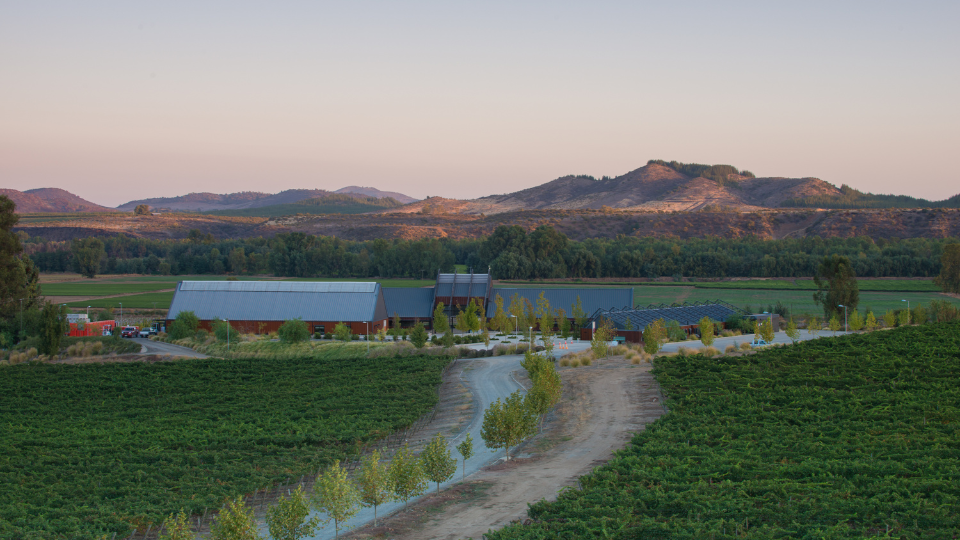- Innovation
- December 1th, 2022
Viña Concha y Toro’s Center for Research and Innovation celebrated its eighth anniversary
The CRI’s work has resulted in plants free of some viruses and fungi that will make vines more resistant and thus extend their useful life, as well as generate up to 18% savings in irrigation water.
Viña Concha y Toro’s Center for Research and Innovation celebrates eight years since its founding, and celebrates it by sharing its main innovation success stories, highlighting the focus on adaptability to climate change.
One of them is the beginning of the planting of what they internally call “Plants 2.0”, that is, a vine free of 13 viruses and 5 wood fungi, which will extend its life and will be more resistant to climate change, the company announced at a ceremony held in Pencahue, Maule Region, with the presence of Sofia Valenzuela, Seremi of Science, Technology, Knowledge and Innovation of the South Central Macrozone of Chile.
“Viña Concha y Toro’s Research and Innovation Center is an example that we hope the private sector will follow. It has been a great contribution not only for the Maule region, but also for the country,” said the Seremi.
It is an example not only of the role that private enterprise should play in research, she said, “but also in regionalization, which is one of President Boric’s mandates, as well as in capacity building by receiving thesis students. He also congratulated the CRI for the incorporation of women in science.
“Faced with the climate change scenario, we will require more research and development to adapt to climate change,” she concluded.
Rafael Guilisasti, Vice Chairman of the Board of Viña Concha y Toro and Chairman of the CRI’s Board of Directors, said, “Eight years ago we created the CRI, a project that began as a dream to develop R&D within the company. Today it is recognized by the national and international academic community and public agencies that develop science and technology policies. The CRI keeps us at the forefront of the global wine industry and brings us closer to the vineyard and winery of the future, developing and adapting the latest advances in science and technology”.
This achievement is the result of the joint work of the Agricultural Division and the CRI, of a program that began in 2016 based on the most sensitive analytics available in the world, qPCR, based on sanitary selection and cleaning of viruses and fungi.
“This is the first time that Viña Concha y Toro has carried out a vineyard planting with this superior plant material or “Plant 2.0″, which consists of a vine plant free of 13 viruses and 5 wood fungi, which affect the productivity and longevity of the vineyards,” comments the director of the Center for Research and Innovation, Álvaro González.
The 2.0 plants will be healthier, more productive and longer-lived than their predecessors. They will be plants that will be more prepared for climate change, he adds.
The first planting of Plants 2.0 took place in October at the company’s El Triángulo Estate, located in the Fifth Region, which marks the beginning of a new quality standard for the plants grown in Viña Concha y Toro’s Agricultural Division’s nursery.
“This important milestone has been the fruit of a CRI research and development program that began in 2016 and today is already a concrete case of innovation, improving the productivity and longevity of our vineyards and adding value to the work of our agricultural area,” says Álvaro González.
It is expected that, in the future, Viña Concha y Toro will have plants free of 12 viruses and reinforced with trichodermas (beneficial fungi), which means even more robust plants than those currently planted.
18% water savings for irrigation
Another relevant success story is precision irrigation. Four years ago, a new water efficiency project was launched at the CRI, which consists of implementing an irrigation management system based on the development of crop coefficient (Kc) curves in different of the company’s fields, which, together with the analysis of meteorological information, makes it possible to calculate the specific water demand for the vineyard. That is, when to irrigate and how much to irrigate.
This plan is currently applied to 900 hectares of the 10,000 hectares planted by the holding company in Chile, which has led to savings of 18% on average in the amount of water used.



